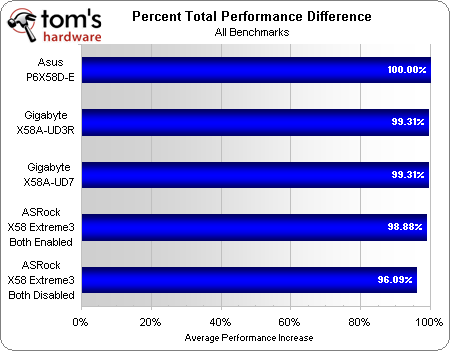X58 In 2010: Four LGA 1366 Boards With USB 3.0 And SATA 6Gb/s
The March 2010 launch of Intel's hexa-core Core i7-980X gave us a good reason to revisit the LGA 1366 interface. Today, we're looking at four new X58 Express-based motherboards that tie USB 3.0 and SATA 6Gb/s support in to Intel's flagship platform.
Conclusion
The addition of USB 3.0 and SATA 6Gb/s controllers is nothing more than an evolutionary step in X58 motherboard design, and all of today’s boards used the same parts to address these technologies. Aside from those updates, frankly, none of today’s motherboards stood out in any technically-interesting way compared to previous-generation parts. The Asus and Gigabyte solutions aren't able to accommodate three double-slot graphics cards within an ATX case’s seven-slot confines, and ASRock even centered its third slot on PCIe 1.1 connectivity in order to free up a couple PCIe 2.0 lanes for its new onboard controllers. The performance difference between the Asus and Gigabyte boards falls within the 0.7% difference in base clock.
Yet, while none of the technology strikes us as exceptionally new, one product stood out by providing a great amount of it for an incredibly low price. Priced around $150 less than its "big brother" UD7 model, Gigabyte’s X58A-UD3R has nearly as many onboard features. The X58A-UD3R even offers more features than Asus’ mid-priced P6X58D-E, for a price roughly equal to ASRock’s lower-cost model. With consideration for the price premium that normally accompanies X58-based products, we simply haven’t seen a motherboard value this good since November of last year. That level of value earns the X58A-UD3R an award.
Meanwhile, there’s the low-cost ASRock X58 Extreme3. A BIOS issue that caused performance to drop dramatically when any of its onboard controllers were disabled has been solved with version 1.52, but to keep things fair from a development time perspective we simply retested the board with its previous BIOS version after enabling all controllers. Anyone who doesn't need all of the winning Gigabyte board's features might find value in ASRock's slightly lower price.
Get Tom's Hardware's best news and in-depth reviews, straight to your inbox.
-
Tindytim First Intel punishes me by not releasing a proper 32nm 920 replacement for the 1366, and then Tom's publishes this article only days after I purchase components for yet another 1366 build.Reply
I must be a BYOPC masochist. -
Stardude82 Nice to see that mobo makers aren't charging too much of a premium for USB 3.0 and SATA-6. On the other hand, what an embarrassing for ASRock just as I thought they were getting out the shadow of ASUS.Reply
I would have liked to see those new ports put to use on these boards... -
omoronovo I very recently decided to take the plunge in an i7-based build, and I chose the UD3R for it. I couldn't be happier - this little monster pushes my i7 to 4ghz stable on stock vcore.Reply
One thing I haven't seen anywhere though, but would like to, is the overclocking variance added through differing ram capacities. Even though I reached 4ghz on stock vcore, I had to push my QPI to 1.35 to keep the system stable with 6 modules installed. With 4 modules, this was reduced to 1.28, and with 3 it was around 1.24 and with only 2 I could run the QPI volts at 1.2.
Perhaps an idea for an in-depth article at some point in the future Toms? -
liquidsnake718 Thank you TS. I think you may have built and benched my new computer. I see you still chose the 920 over the 930. Even before reading this article, I had my eyes on the UD3R because of the price and the decent features, save the sound card. However because of this article, I am going to reserve this mb and start building a newbie!Reply
The next step would be to see how these boards stack up using 6 cores and letting people know what power with 6 cores means using a 1 & a half year old motherboard. Although knowing that 6 cores, USB3.0 and SATA 6.0gb are a long way from being standard, it is by no means premature to have this board as one knows that they will be paying and buying for the long haul! The smartest ones do, and seeing as you guys chose the best parts for the price in terms of quality/performance, the UD3 is a perfect fit for a 5850 or maybe 2!
You should send this article to someone at Intel and maybe they will want to soon follow the way of USB3.0 for their vanilla board! I guess these builds are the new standard for high end or borderline excellent.
-
anders_w An error/typo in the table page 2?Reply
http://www.tomshardware.com/reviews/x58-usb-3.0-sata-6-gbps,2614-2.html
The table claims Asus P6X58D-E have Chipset S-ata 6 x SATA 6.0 Gb/s
Should probably be 6 x SATA 3.0 Gb/s... -
Crashman anders_wAn error/typo in the table page 2?http://www.tomshardware.com/review 614-2.htmlThe table claims Asus P6X58D-E have Chipset S-ata 6 x SATA 6.0 Gb/sShould probably be 6 x SATA 3.0 Gb/s...Reply
Thanks. -
C 64 At first quick look at the picture I almost fell from my chair... a quad processor MB, but then I realized Tom had problems squeezing the MBs in the pic.Reply
-
Crashman zipzoomflyhighAnother X58 reviews. Just what we all wanted. NOT.Yeh, X58 is obviously exceeds your needs but there hasn't been much news on the Via Apollo Pro front.Reply -
abhishekk89 i'd been planning on a p55 chipset + i5 750... now i'm thinking of i7 930 + gigabyte ud3rReply


